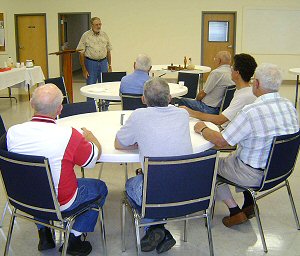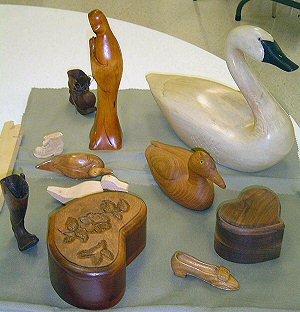Foley Wood Carver Dwayne Miller
Discusses History of Wood Carving

"Wood carving developed as a craft based on what was needed. Much of its history has been lost. Even within modern memory we remember that wood craftsmen built rakes and pitch-forks and buckets." Foley's master wood carver, Dwayne Miller, explored the history of wood carving and its evolution from a home craft to an industry to a folk art skill as he discussed his discovery of the wood carving art with an audience at Silverhill Zion Lutheran Church's "Men's 710" at its June breakfast and speaker program. "It is interesting that the medieval church is one of the reasons that the wood carving art was preserved to modern times, primarily because of the wood work in churches that were developed prior to the Reformation." That impetus caused wood carving schools to be developed in many European communities.

Foley Wood Carver Dwayne Miller shared breakfast and
discussed working with wood at the June "Men's 710." Young men and
seniors admired his handiwork (table to right of speaker) as Miller (by
podium) wove a wood carver story stretching from the craft's birth as a
home industry to its current position as a home craft. Miller has
practiced this craft for over 20 years.
With the Renaissance, what had been practical for church beautification, became art in a new sense. Wood carving was applied to the application of frames for paintings encouraged by the times. "The wood carving craft blossomed along with art, but the industrial revolution soon put an end to that application of the wood carving art because things could be copied by machine," Miller observed. People are flexible, though. Wood carvers migrated to where the livelihood was. They began to work in the ship-building trade and in the fabrication of special farm implements including weather vanes, rakes, hay forks, etc.

There is great variety to the wood carving craft. Master
carver Dwayne Miller showed the "Men's 710" group a variety of "shoes,"
"ducks," "swans," "boxes," and figurines.
The wood carving craft has always been practiced in either a three-dimensional form or in a quasi-two dimensional form called "relief." The symbol of tobacco, an American Indian, came out of this redeployment of wood carving skills which goes back into the 1800s. Many images of Cuban American Indian natives were carved by the thousands and were deployed around the world in support of the American tobacco industry. Those carvings, just like the picture frames a couple hundred years earlier, were replaced by industry applying machinery to make multiple copies of one basic model piece.
Would you believe that wood carvers "lost market share" and again moved on to other things? "In the latter part of the 1800s the U.S. was flooded with immigrants who could not read. Wood carvers began to fabricate custom 'trade signs' which were their primary business until the advent of the 'neon sign' replaced the carved sign. Illiterate people could "read" a wooden sign if they recognized the carvings. The Smithsonian is collecting wood signs by these craftsmen, but they are now very hard to find," Miller noted. Wood carving as a profession waned with the advent of electric signs, but since World War II wood carving has reinvented itself as a hobby or home craft.

Wood carver Dwayne Miller, thumb glove on his right hand and
holding a carving knife, demonstrated some of the wood carving tools
used by the craft (left to right): the gouge, another gouge, the
chisel, the carving knife, the V-tool, and another V-tool. There are
many sizes of these tools, each with a specific application. The
wooden mallet is used with these wooden-handled tools to preclude
cracking of the handles. Notice that the carving knife in Miller's
hand differs from the pocket knife we all are familiar with because the
cutting edge is on the straight side of the blade.
There are three primary wood carving tools which come in hundreds of sizes, the V-tool with angles of 1 to 179 degrees, the gouge with its rounded head, and the chisel with its straight edge. These basic tools are supplemented by two additional tools, the "carving knife," and the palm cover or leather glove which protects the wood carver's thumb. "And don't forget the wooden mallet," Wayne was quick to add, "because when you use a wooden mallet on wooden tool handles, you don't get cracks in your tool handles."
Bass wood is the most popular wood to work with in this country. "It is white and light and has virtually no grain," Wayne notes. "Walnut is the second most popular with oak following in popularity. Churches like oak. Wood rot is the result of moisture, heat, and oxygen. Several woods are used because they are especially resistant to rot, woods like sedge, catalpa, cyprus, and cedar are examples."
Wood carving is both labor and time intensive. Time can be shortened by making big cuts in wood and roughing in pieces. But even apparent small craft items may have very substantial time invested in their workmanship.






|
|
|
|